
CONTACT US FOR A FREE DECK BUILD ESTIMATE IN FREDERICK
What Type of Deck Material Should You Choose?
Deck Material Options in Frederick MD
What type of deck material should you choose? Here are some tips and information to help you decide which is the right decking material for your deck.
Choosing a decking material used to be easy. Wood was the only option. Now there are many options, including composites, plastics and aluminum, which many people are not aware of.
While many people will continue to consider wood the best decking material, the newer options offer many attractive benefits such as longer life-span and lower maintenance.
For such an important decision, it’s important that you take your time researching your options. You might be surprised at the number of options available. Below are some of the most popular choices.
Wood Decking Material
There are various types of woods used in deck building. Wood is the original and still holds the title of most popular type of deck material. It’s strong, natural, and easy to install. It does require an annual cleaning, and, if not maintained correctly, it can rot as well as warp and splinter.
Areas of a wood deck that are exposed to the elements will turn gray. Annual maintenance and re-staining every 2 to 3 years will help to keep the deck solid and good looking.
Pressure-Treated Wood Decking
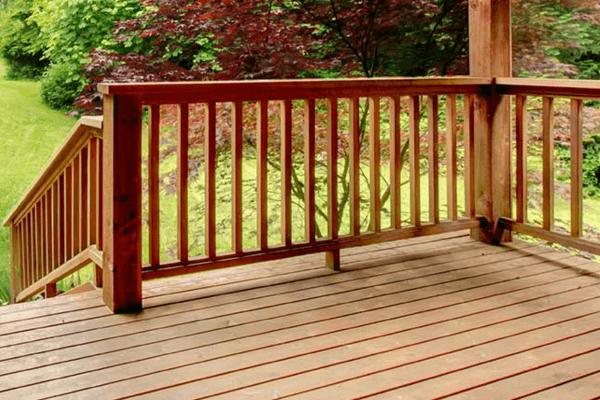
Pressure-treated lumber is one of the most popular types of wood decking.
This type of deck material is durable and lasts for about 15 years. Southern yellow pine is the most common type of pressure-treated wood. Unfortunately, it is easy to splinter and needs to be maintained to prevent it.
That said, it is easy to find and cut, and it is easy to work with. A stain can be applied to your pressure-treated lumber to change the color, and enhance its aesthetic appeal.
Although all lumber can be treated with different chemicals, pressure-treated lumber is impregnated with anti-rot and insecticides to increase its natural durability.
It is important to wear gloves and a mask when working with this wood. Toxic chemicals that prevent termites and rot in the wood can be dangerous to your health. This also means you should never burn this type of wood. Being highly corrosive, it is necessary to only use stainless steel fasteners to achieve the best results.
It is recommended that your deck is allowed to weather for at least a month or more before staining. Sanding before applying stain can also help. You should also know that there are many grades of treated lumber. We can help you choose the right grade.
The most significant difference between composite and wood decking is how common lumber tends to split, warp or crack.
Regular maintenance is required for pressure-treated wood although, you can prolong the life of your pressure-treated wood deck by taking care with power washing, sanding, and regular re-staining.
Tropical Hardwood Decking
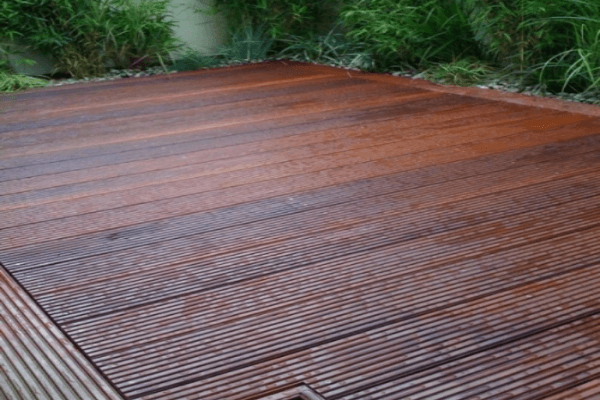
A great choice of deck material is exotic hardwoods such as Ipe wood.
Hardwoods have a distinct advantage: as their name suggests, they are hard.
Because of their dense structure, hardwoods are resistant to insects, decay and rot. They contain natural tannins, which work in a similar way to chemicals used to treat pressure-treated lumber.
Each hardwood is unique. Ipe, for example, is a deep crimson brown color that fades to a soft gray color when it isn’t oiled at least once a year.
Mahogany, Cumaru, and Tigerwood are other hardwood options.
Hardwoods are more durable than softwood and can look better over time due to their density.
Some hardwoods are slow growing and are not dense in the areas where they are harvested. There has been much debate over how sustainable these species are. This concern can be addressed by a variety of online resources.
Many factors influence the choice of deck material options, from cost and appearance to maintenance and installations.
It is important to fully understand your options in order to make the right choice when deciding on a deck building material.
These woods are expensive and heavy. They are, also difficult to work with.
It is advisable to avoid dark woods when your deck will be exposed to a lot of sunlight. They tend to absorb the heat and can become extremely hot, too hot to walk on in bare feet.
Redwood and Cedar Decking
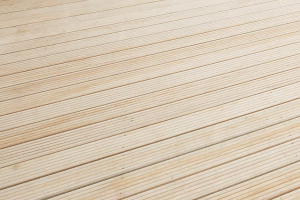
Cedar and Redwood are often regarded as a better-quality or a level above pressure-treated lumber. The natural wood slowly turns a soft gray over time. This wood is lightweight and easy to use, making it ideal for DIY projects. Natural tannins in cedar make it resistant to insects, decay, and rot.
By nature of their origin, these woods have natural protection against insects and rot, so they should last for 20 years.
However, they are soft and can be easily damaged by general foot traffic. Red cedar and redwood can be both light and stiff. If this is your choice, consider Port Orford Cedar, which a lighter-colored cedar, but is the most durable and wear-resistant.
Although Cedar has similar properties to redwood, Cedar is more dense and can bend more easily without breaking. Cedar also contains less oil, making it easier to stain.
Cedar forests are more common than redwood forests. This makes cedar the more eco-friendly and affordable deck material option of the two.
Because of its rich, red-brown color, Redwood was once more popular than it is today.
Redwood is also one of the strongest woods in terms of fire resistance.
Redwood is now less readily available due to excessive logging. The newly grown trees that are currently on the market aren’t as strong and as resilient as the older grown redwoods which was also a factor that previously made them more popular.
Most redwood is available on the West Coast from where it is sourced.
It’s important to note that it is recommended to power-wash and sand Redwood and Cedar decks every three years.
Although the material is durable, as a natural material, it will inevitably turn to gray as the sun fades its original color.
To keep it bright, a sun-blocking stain must be applied. Fine cracks and splits can be prevented to some degree by using a water-repellent wood preserver.
Composite Decking Material
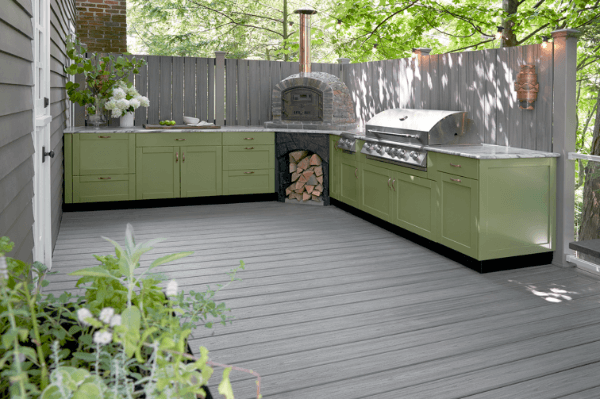
There are many kinds of composite decking. Composite refers to a combination of different materials that create a finished product. Wood and low-density plasticethylene (LDPE), are most commonly used together. However, some products also use rice hulls and high-density ethylene, as well as other materials.
Composite type of deck material is durable and can withstand harsh environmental conditions.
Composite decking is available in many colors including some that resemble wood and can be used in any type of deck.
Composite is known for being very scratch-resistant, but this can vary between brands and price points.
As you would expect, composite decking requires very little maintenance and doesn’t require any sanding or repainting.
The most common maintenance is to wash your deck once a year. Trex Composite Decking, a high-quality material that can last 25 years with minimal maintenance.
Depending on the price-point, the costs can vary greatly between manufacturers, as well as the number of different colors available.
Composites such as Trex and Brasilia can look just like real wood, and are available in many natural-looking colors and patterns. These boards are made from a mixture of plastic and wood fibers and will not splinter. They also do not require any staining or painting because of their resistance to UV.
Composites generally do cost more than wood and, to prevent mildew, they require frequent cleaning. However, if you calculate the cost of maintenance and necessary re-staining of wood decks, then there really is little, if any, cost difference in the long run.
Composite decking boards can be made lighter by having grooves on their underside. This does not compromise its stiffness. Hidden fasteners can be used in board edges which will make the deck floor look seamless.
If you decide on composite material, be sure to check out the lifetime warranty of the product, as they range from 10 years (or less) all the way up to 25 years.
Finally, many manufacturers can use recycled materials without any impact on their performance due to the nature of composites. Some brands even use 95% of the recycled materials.
If you’re interested in reducing your carbon footprint, please refer to the individual manufacturers information and how they work with those goals.
Aluminum Decking Material
Aluminum might seem like an unusual type of deck material, but it is actually a great material for decking, even though it is less popular than the others.
Aluminum decking is lighter than vinyl, composite, or wood and more resistant to weather, mold, and of course, insects.
Although you may not be planning that far ahead, aluminum decks can even be recycled.
As you may suspect, Aluminum decking is the most expensive option for decking because of all these attributes.
The Plastic (PVC) Type of Deck Materials
There are many quality levels for polyvinyl chloride plastics, but almost all are very tough and hard-wearing. High-quality PVC decking has practically none of wood’s weaknesses.
Vinyl decking requires virtually no maintenance. There is no need to sand or stain plastics.
Vinyl offers a wider variety of color options including brown, gray and white as well as patterns that replicate the look of wood grain.
PVC offers more options for aesthetics than regular lumber.
Since its inception more than 20 years ago, solid PVC decking has seen various improvements.
It’s lighter than synthetic decking materials and therefore easier to transport around the job site. You may choose this deck material depending on the type of deck you’re considering.
PVC decking does have some drawbacks, such as the high cost and low recycled content which is not eco-friendly especially if it is 100% virgin.
PVC decking can also be more expensive than wood.
The increased cost of PVC materials can be offset in the long term by the lower maintenance costs. PVC decking is more likely to be made from recycled material than other types of synthetic decking.
However, some PVC decking products are 100% virgin. This can increase the carbon footprint, without necessarily mean a better deck board.
Cellular PVC vinyl decking (plastic) is a totally manufactured type of deck material, and contains absolutely no wood. It is more durable than composite decking materials and has the ability to last for an extremely long time.
Apart from the occasional cleaning, cellular PVC vinyl decking is virtually maintenance-free.
Unfortunately, it doesn’t really feel or look like wood, and the boards creak when you walk on them.
The boards are fastened with complex systems that allow the pieces to move according to temperature.
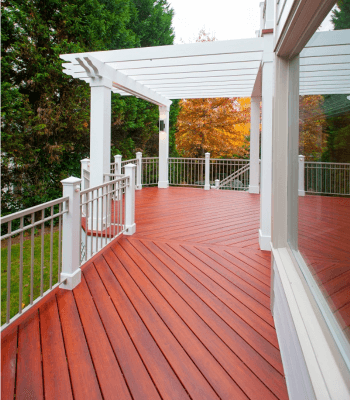
Frederick MD Local Deck Building Contractor
Licensed, Bonded, and Insured
MHIC #120704
Contact us for a Free Estimate.

Are You Wondering What Deck Materials You Should Choose?
If you are not sure which deck material is right for your deck, contact us.
We will listen to what you would like to build and, after we take some measurements, we’ll be able to give you free estimates based on each of the various materials.
Not only that, we’ll be able to show you the different materials and explain their pros and cons.
When you have all the information you need, you’ll be better place to make your choice.
We’re here for you. Give us a call.
Experienced Decking Contractor in Frederick MD
We are Licensed, Bonded and Insured

Frederick Decks & Porches
201 E. Patrick St.
Suite 4078
Frederick MD 21701